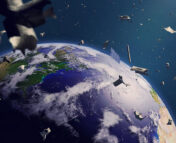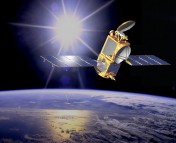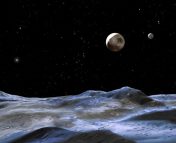Title: Investigating the risks of debris-generating ASAT tests in the presence of megaconstellations
Authors: Sarah Thiele and Aaron C. Boley
First Author’s Institution: University of British Columbia, Department of Physics and Astronomy
Status: Included in conference proceedings for the 2021 AMOS Conference
On November 15, 2021, Russia’s Ministry of Defense conducted an anti-satellite (ASAT) missile test, which hit the satellite COSMOS 1408 and ejected debris into low-earth orbit (LEO). ASAT weapons are designed to destroy satellites for military purposes, but so far they have only been used in tests by a country on its own satellites. Since 1979, researchers have warned that a high enough density of objects in LEO could lead to collisional cascading, where one collision creates debris which causes more collisions and so on. This is sometimes referred to as “Kessler Syndrome,” in reference to Donald Kessler, who first proposed this danger. Such a scenario would make space activities and the use of LEO satellites severely hazardous or even impossible for decades. Today’s paper examines how the risk of collisions from ASAT test debris increases due to commercial satellite mega-constellations, such as SpaceX’s Starlink.
A Crowded LEO
Today’s paper was part of the Advanced Maui Optical and Space Surveillance Technologies Conference (AMOS) in September 2021, preceding the November ASAT test. So, this work instead focused on an ASAT test by India’s Defence Research and Development Organization in March 2019, referred to as Mission Shakti, which successfully destroyed the Microsat-R satellite, an experimental imaging satellite for military use launched by the Indian Space Research Organization just two months prior. Preceding this event, three other countries had demonstrated ASAT technology: the United States, China (shown in Figure 1), and Russia.
Figure 1: Visualization of the Chinese ASAT Test in 2007 and resulting debris, with a comparison to the International Space Station’s (ISS) orbit and other known satellites and debris in Earth orbit. (Video by Analytical Graphics, Inc.)
Commercial satellite mega-constellations (satcons) are projected to increase the number of satellites in LEO by more than an order of magnitude in the next few decades, meaning that the danger produced by collisional events and fragmentations is growing rapidly. For example, the Starlink satcon had 1645 satellites in orbit at the time this paper was written. They plan to increase that number to 42,000 by the year 2027. Additionally, at least 8 other internet providers have begun to or are planning to launch their own satellite constellations. This paper calculated the probability of collisions due to an ASAT test in 3 different scenarios:
- only the satellites in LEO in 2019 (~3,000)
- the first 12,000 planned for Starlink’s constellation over the next few years
- the long-term plans for a series of commercial satcons adding up to 65,000 satellites.
Calculating Collisional Risk
The authors used the NASA Standard Breakup Model (NSBM), as well as a more simplified Rayleigh distribution model to estimate the number, sizes, and velocities of fragments resulting from an ASAT test like that of India in 2019.The NSBM calculation predicts that such an event would produce more than 300,000 debris fragments between the size of 3 millimeters and 1 meter. However, most of these would be quite small, and the predicted number for fragments over 10 cm (roughly the size that current technology can track) was 1168. The orbits of these debris are shown in Figure 2.

Figure 2: Gabbard plots, which show apogees (maximum distance from Earth along orbital path) and perigees (minimum distance) for the debris from ASAT tests. From left to right: NSBM model for debris above 10 cm in size, the simplified Rayleigh model, and the actual data from the 2019 ASAT test. The gray point marks Microsat-R’s orbit at the time of the test. The dashed line shows the orbital altitude of the International Space Station (ISS) and China’s Tiangong space station. Each of the three panels show debris scattered throughout the LEO range (<2,000 km), including many that pass through the altitude of the space stations’ orbits. (Figure 1 in the paper)
The authors used an N-body modelling software called Rebound to track the expected paths of these fragments until either atmospheric drag pulled them out of orbit, or a period of 2 years after the test ended, whichever came first. Along each fragment’s path, they calculated the probability of collision over time, based on the satellite distribution for each scenario. Combining these probabilities for all of the fragments in a given scenario, they calculated the total probability that one or more collision(s) would occur as a result of a single ASAT test.
So, how dangerous is it?
The authors found that the probability of collision increases dramatically in a satcon environment, compared to the orbital environment of 2019. For the future scenario of 65,000 satellites in LEO, the odds of a collision with a relatively large (>1 cm) fragment, which would cause severe damage to a spacecraft in a collision, would be roughly 30% for a single ASAT test. Taking into account smaller fragments down to 3 mm, this probability approaches 100%. In the 2019 configuration, the probability of any collision was already a non-negligible 10%, while the probability of a large fragment (>10 cm) collision was only 0.05%. While collisions caused by smaller debris fragments, which cannot be tracked from Earth, may not be catastrophic, they still contribute to the overall debris population and should not be ignored. Even very small impacts may damage electronics like solar panels on operational spacecraft.
Debris in LEO endangers the functionality of any satellite, as well as the safety of humans on board the International and Tiangong space stations. With so many objects orbiting there, including satcons, anti-satellite tests are becoming increasingly dangerous, and they must stop if humanity is to maintain a safely operating LEO environment. Of Earth’s orbital space, LEO requires the least energy to reach. Satellites operating there can have low latency and high bandwidth, while space stations there are more easily accessible for crewing and servicing. Without LEO, humanity would lose access to important global communication technology, as well as the ability to perform scientific experiments in space, like those performed on the ISS.
Edited by Briley Lewis
Cover Image Credit: Marco Langbroek (The Diplomat)




